In the Realm of the Senses - Bologna Cheese10/18/2011 I like cheese, but I'm not as passionate as some. Passionate cheese lovers love the smell as well as the taste of a good cheese. Nothing, however, prepared me for the onslaught of the wonderful heady aroma enveloping me when I walked into this small shop in Bologna, Italy. As I recall I was walking down via Oberdan a few blocks from the Piazza Nettuno when I saw this small shop on the corner.
0 Comments
Arancini8/24/2011 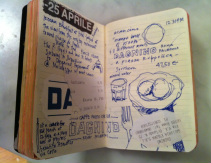 My Scrapbook Entry for Dagnino Last year Chris' friend in Rome said Pasticceria Dagnino had the best pastries in all of Rome. Before moving on to Bologna , we thought we'd better check it out. The bakery also had a cafe that served lunch so we sat down and had a bite to eat. Next to us a 3 generation Italian family sat down and immediately ordered these delicious looking fried balls. As soon as the plates were on the table, the entire family dived in and devoured them. Not being able to resist, we asked the waiter to bring some for us as well. Arancini are cheese stuffed balls of risotto that are deep fried. They are delicious and we thought we found a new and unique Italian dish.  Lo and behold, when I returned to my normal routine in San Francisco of shopping at Trader Joe's -- what do I SEE! Arancini Bites in the frozen food section! I guess Trader Joe's is on the ball for finding things new and exciting. Back of the House - 17/28/2011 This is perhaps the most recognizable building in the world, but you only see photos of it from the front. Walk around to the back and another story is told. The front is clad in stone, but the rear has exposed brick. I'm not sure how this looked when it was originally built, but if there was stone here originally, it is now gone. 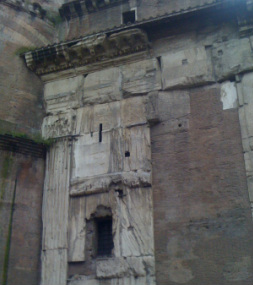 Pantheon rear August 3, 2011 Update: I was looking at some of my other photos I took of the Pantheon and I clearly see remnants of old stone cladding over the brick which is now mostly gone. 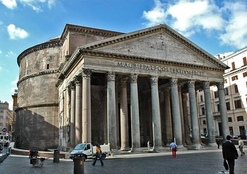 Front of Pantheon - Rome The Pantheon is the oldest building in Rome that has been in continuous use for 2,000 years. Click the photo for a link to a website describing the history of the building. 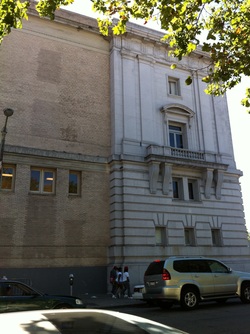 Bill Graham Civic Auditorium - San Francisco The idea of saving money on the backside of the house isn't a new one. Here in San Francisco if you stand in the middle of Civic Center Plaza, all you can see are granite clad buildings. On the south side of the plaza sits Bill Graham Auditorium. Built in the 1920's by architects John Galen Howard, Frederick Meyer, and John Reid, Jr., it fills out one side of the plaza with historic classicism. Walk around the building, however and you will see the building clad only in brick. The back of the building is quite visible as you cross Market Street, so the decision to clad it in brick rather than granite was probably to save money. They turned the granite around the corner just enough to maintain the view from the plaza. Enter at your own Risk7/18/2011 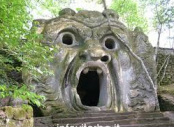 Sacro Bosco - Bomarzo, Italy This doorway at Opera Plaza near San Francisco's Civic Center at 670 Golden Gate Avenue is left over from the former Vivande Restorante. It appears to be inspired by the post-renaissance garden Sacro Basco in Bomarzo, Italy and called Dante's "Gates of Hell". Here fantastic figures abound in this example of the mannerist movement dating from the 16th Century. It makes a memorable doorway for an Italian restaurant, but now it is a doorway to a mortgage company. You may feel a little queasy going in to sign your life away. Totally out of character for its current use and out of character for the entire building, I've always wondered why it is still there. It makes for an interesting doorway at any rate. Berkeley Post Office - Echos of the Past7/11/2011 On my way to a meeting with the Berkeley Planning Department, I passed one of my favorite buildings, the Berkeley Main Post Office at 2000 Allston Way near the Civic Center. Like many neoclassic public buildings of the late 19th and early 20th century, they are inspired by the renaissance buildings in Italy. The post office is clearly a descendant of the Foundling Hospital in Florence, Italy designed by the great architect Brunelleschi at the beginning of the renaissance. Consider one of the first renaissance buildings, it has inspired buildings around the world. The post office was designated an historical landmark in 1981. Not bad for a copy.  Cobb Elementary School - San Francisco Follow-up note: Just two blocks down Pine Street is Cobb Elementary School - another descendant of the Foundling Hospital. Thiebaud and Morandi6/30/2011 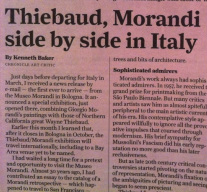 Museo Morandi in Bologna, Italy has a joint exhibit of two artistic heroes -- Northern California artist Wayne Thiebaud and Giorgio Morandi. Both studied simple still life objects for a lifetime. Although different at first glance, once examined you can see many similarities in their approach. According to the SF Chronicle article by art critic Kenneth Baker, Thiebaud was a fan of Morandi and owned several of his paintings. This exhibit closes in October and is scheduled to travel and come to the Bay Area. I will be looking for it! 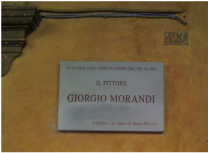 Hidden away on a side street in Bologna, the museum is located in an old apartment building and was Morandi's former home. Other residents still live in the gated courtyard building. Spot the small sign and ring the doorbell to gain entrance. Go up a narrow set of stairs and transition from the historical Bologna streets and buildings to a museum bright, modern, and a study in minimalist Italian architecture -- a wonderful transformation. I encourage you to visit if you can. 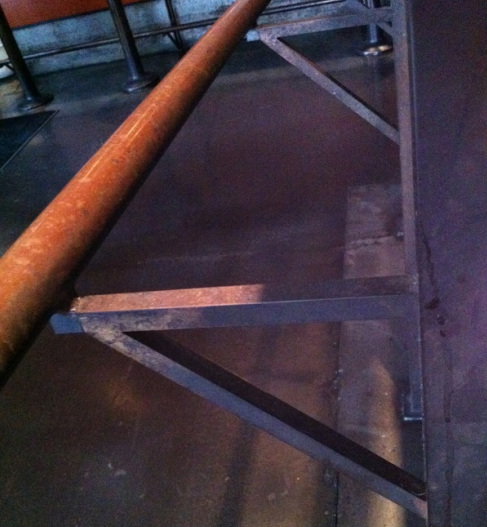 Handrail at the Slow Club - San Francisco Could it be that the Slow Club has been around for 20 years? The industrial chic look that exploded on the scene during first dot-com bonanza was spear-headed by restaurants such as the Slow Club at 2501 Mariposa. Bare concrete, steel, and wood, seasoned the space with a studied tough no fuss attitude. It was noisy, crowded and the food prepared in the exposed kitchen was good. The bar at the back of the restaurant is connected to the main dining room by a ramp with these hand rails. Handcrafted angular steel brackets hold up the wood handrail. Notice where the bracket attaches to the wood handrail. If you are truly gripping the handrail, your hand will hit the handrail. This is the same problem with the handrail at the Bakar Fitness Center in San Francisco. Contrast this with the curved handrail brackets at the Brera Museum and at the Tivoli Garden's villa d'Este shown in an earlier blog. Those Italians designers were really thinking! 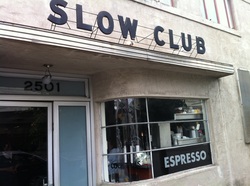 Slow Club Twenty years later, the Slow Club looks the same and still contemporary -- others have caught up. Now it's less crowded, but the food is still consistently good. I'm always there for lunch, never for dinner. Presidio Library - San Francisco6/7/2011 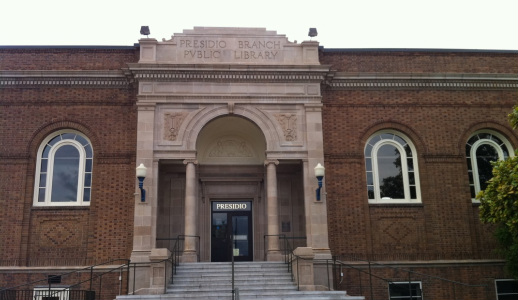 Presidio Branch Library - San Francisco The Presidio Branch Library on Sacramento Street is my neighborhood library and I've loved it since I moved into the neighborhood. The building was built in 1921 with Carnegie funds by the beaux arts trained architect Albert Lansburgh. This year the library re-opened after a $4M renovation. The renovation left both the interior and exterior largely intact with no obvious trace of the work completed - probably a good thing. When I first moved to San Francisco, I read the novella "Trout Fishing in America" by Richard Brautigan, a San Francisco author who died tragically young. I didn't realize it at the time, but he was a frequent visitor to this library and used it as a setting for his 1970 novel "The Abortion". A few years ago they had an exhibit of his work, letters, and relationship with the library. 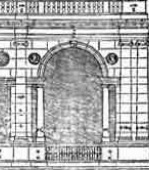 Drawing by Andrea Palladio Presidio Library Architect Albert Lansburgh followed the trend at the time of incorporating "classical" architectural elements into public buildings. In this case, he was clearly looking at works by the great Renaissance Italian architect Andrea Palladio. Palladio is perhaps one of the most influential architects of all time as his work has inspired buildings around the world for over 500 years. The often copied palladian arch featured a central arched opening with two small side openings separated by columns. The renaissance palladian arch is actually derived from earlier triumphal arches as seen in the Roman Forum two thousand years ago. The drawing at the left is the palladian arch drawn by Palladio for the Basillica in Vicenza that was completed in 1617. Like all "good" architects, I traveled to Vicenza to see the master's work. San Francisco didn't have the funds to cover the entire front with a granite faced palladian facade like the Basillica, but as is common in many public buildings, they put it where they thought it counts the most. Set against a brick background, this singular element contrasts nicely. For a neighborhood library, it's pretty grand. Galleria - San Francisco and Milan6/6/2011 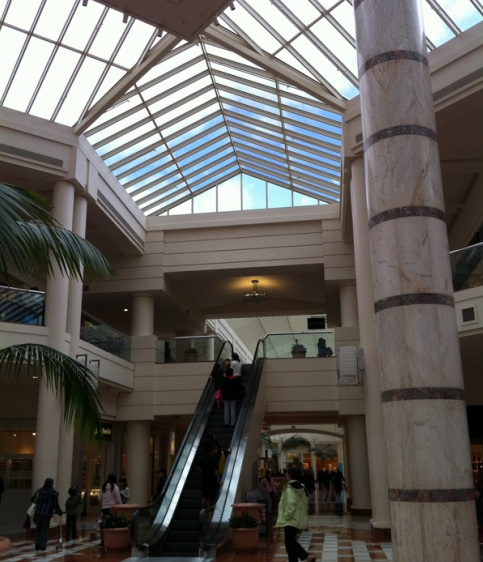 Stonestown Galleria - San Francisco Problems with my iphone took me to the Apple Store in the Stonestown Galleria on 19th Avenue near Lake Merced. Coming out of the escalator I snapped this picture of the main galleria atrium. Built in 1952, Stonestown was the first shopping mall in San Francisco and one of the first in California. Typical of the mall design of 1950's, you could drive and park next to the stores and here was no interior pedestrian street that is common in malls today. The pedestrian atrium above was formerly a "street" with parking. Fading in popularity, Stonestown Shopping Mall was completely redesigned in 1987 enclosing the street with a sky-lit pedestrian area and re-christened the Stonestown Galleria. Its a popular alternative to downtown shopping for people traveling on the west side of town. Located next to San Francisco State University, Lowell High School and across the street from Mercy High School, it's a popular hang out for teens. 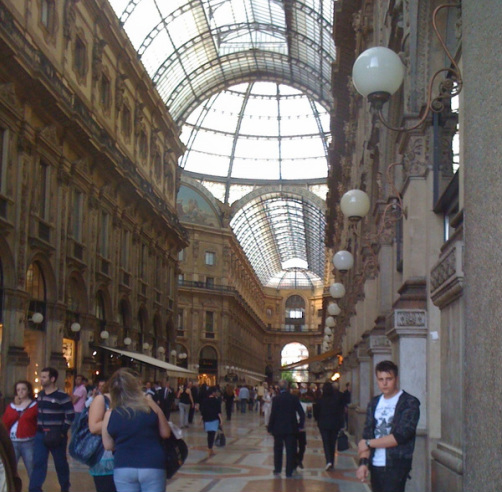 Galleria Vittorio Emanuele II - Milan You might think the sky-lit atrium shopping mall was a 20th century invention, but it has been done before and done quite well. Perhaps the most compelling is the Galleria Vittorio Emanuele II in Milan where the main axis fronts on the main square in Milan -- the Piazza del Duomo with the Teatra alla Scala on the other side of the piazza. Built in 1861, the industrial revolution in Europe made light airy cast iron steel structures like this possible. Inspired by this magnificent space, architects designed new "Gallerias" everywhere. This is the original. 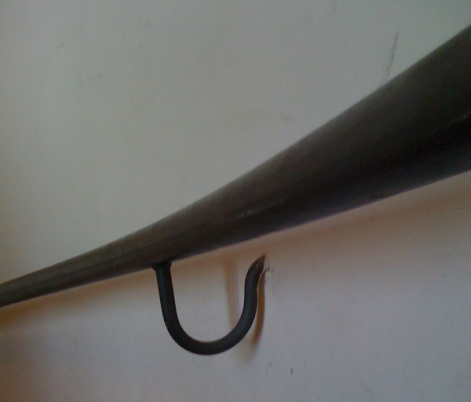 Villa d'Este handrail outside of Rome On May 5, 2011, I wrote about how much I wanted to change the handrail in our Pine Street house. One example I saw last year is giving me ideas about what I want to do. This example here is at the 17th century Villa d'Este outside of Rome at the famous Tivoli Gardens. It looks as if the bracket and the handrail are one seamless element without any interruption of flow. In this case the one seamless element is metal so it is still cold to the touch.
The attachment at the wall is hidden behind the plaster - simple and elegant. As much as I like this design, I still want to avoid the cold touch of metal. Wood seems to be the logical response to this concern, but wood brackets would lack the strength and elegance of this metal solution. My solution would need a hard close-grained wood that is smooth and warm to the touch. The bracket would be metal with a shape and elegance like this one. Stay tuned as I explore the world of handrails. AuthorCatagories
All
Archives
October 2020
Blogs I follow
|
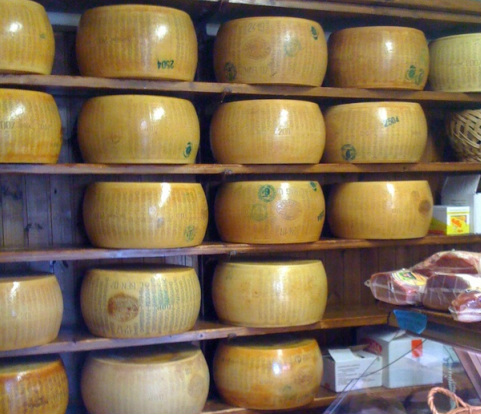
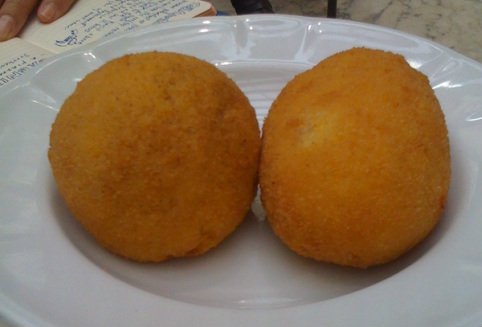
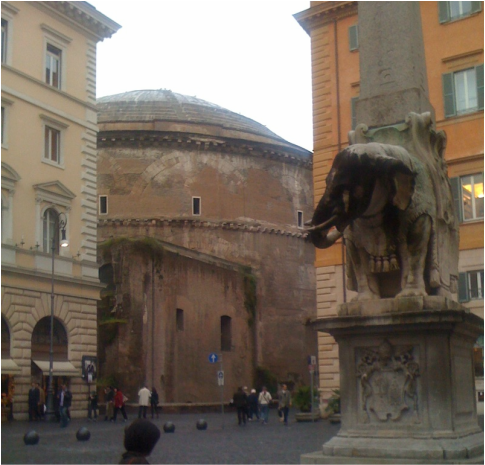

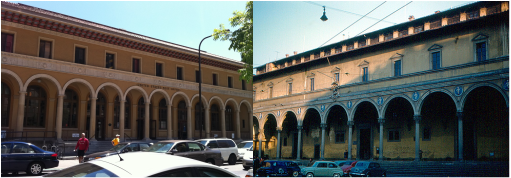

 RSS Feed
RSS Feed
